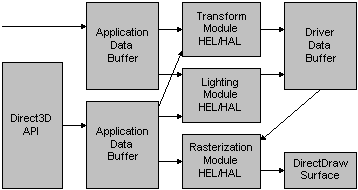
Execute buffers are processed first by the transformation module. This module runs through the vertex list, generating transformed vertices by using the state information set up for the transformation module. Clipping can be enabled, generating additional clipping information by using the viewport parameters to clip against. The whole buffer can be rejected here if none of the vertices is visible. Then the vertices are processed by the lighting module, which adds color to them according to the lighting instructions in the execute buffer. Finally, the rasterization module parses the instruction stream, rendering primitives by using the generated vertex information.
When an application calls the IDirect3DDevice::Execute method, the system determines whether the vertex list needs to be transformed or transformed and lit. After these operations have been completed, the instruction list is parsed and rendered.
There are really two execute buffers: one for the application and one for the driver. The application data buffer is filled in by the application. It holds geometry (such as vertices and triangles) and state information (the transformation, lighting, and rasterization state) This information persists until the application explicitly changes it. The driver data buffer, on the other hand, holds the output of the transformation and lighting modules (that is, it holds transformed and lit geometry) and hands the data off to the rasterization module. There is only one of these "TL buffers" per driver. The following diagram shows the relationship of these data buffers:

You can disable the lighting module or both the lighting and transformation when you are working with execute buffers. This changes the way the vertex list is interpreted, allowing the user to supply pretransformed or prelit vertices only for the rasterization phase of the rendering pipeline. Note that only one vertex type can be used in each execute buffer. For more information about vertex types, see Vertex Types.
In addition to execute buffers and state changes, Direct3D accepts a third calling mechanism. Either of the transformation or lighting modules can be called directly. This functionality is useful when rasterization is not required, such as when using the transformation module for bounding-box tests.